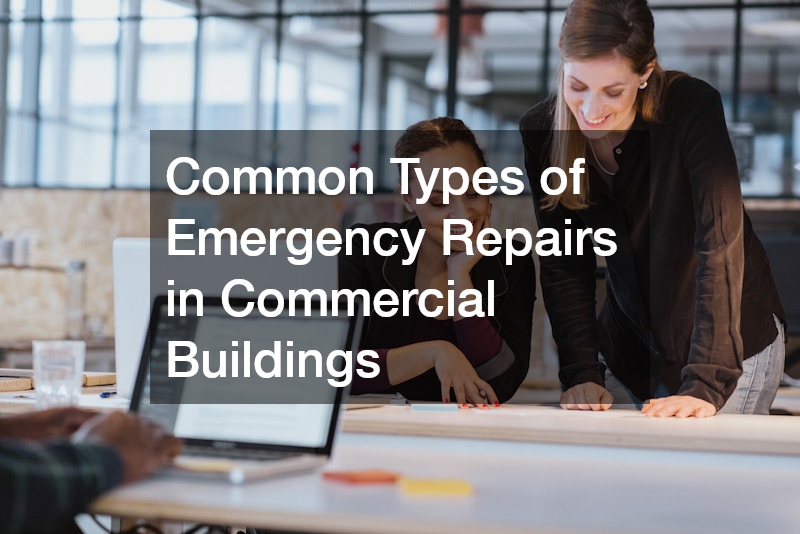Running a commercial building requires constant vigilance and a clear understanding of how to respond when things go wrong. Emergencies can arise at any time — from broken pipes and power failures to malfunctioning HVAC systems and damaged structures. These situations not only threaten your property’s integrity but can also disrupt business operations, compromise safety, and frustrate tenants. Managing them effectively is one of the most important responsibilities a property owner or manager can have.
When an emergency occurs, time becomes your most valuable resource. Whether it’s a leaking roof during a storm, a broken lock jeopardizing security, or a failed cooling system in the middle of summer, how quickly and efficiently you respond determines the level of damage and cost of repairs. A well-thought-out plan, supported by dependable professionals, can make the difference between a controlled incident and a financial disaster.
While commercial buildings vary in design, use, and size, they all share one reality — things will eventually break down. Preparing for that inevitability is not optional. Property managers should always have contingency plans for sudden breakdowns, clear communication procedures for tenants, and access to reliable specialists who handle urgent service needs such as commercial appliance repairs.
Being proactive means understanding which systems are most vulnerable and which services you’ll need on call. That includes knowing when to contact specialists like electricians, plumbers, and HVAC technicians, as well as when to escalate issues requiring immediate shutdowns or evacuations. In this comprehensive guide, you’ll learn how to handle emergency repairs in your commercial building step-by-step, from preparation and response to documentation and prevention.

Common Types of Emergency Repairs in Commercial Buildings
No two emergencies are alike, but some occur far more often than others in commercial properties. Recognizing these potential issues helps you prepare response protocols and identify which professionals to contact first.
1. Plumbing issues – A burst pipe, backed-up sewer line, or flooding can cause thousands of dollars in damage within minutes. Standing water can ruin flooring, damage drywall, and lead to mold growth. Having a plumber experienced in commercial systems is vital for rapid repair.
2. Electrical failures – Outages, faulty wiring, or exposed circuits can shut down operations or create safety hazards. Electrical issues are among the most urgent emergencies because they can lead to fires or equipment failure if not addressed promptly.
3. HVAC system breakdowns – Many businesses rely on climate control for both comfort and equipment safety. Losing heat in the winter or cooling in the summer can make a building uninhabitable. Experienced technicians skilled in commercial appliance repairs and HVAC troubleshooting can restore functionality fast.
4. Roof and structural damage – Severe weather can cause leaks, fallen debris, or structural instability. Roofing problems often start small and worsen quickly, so immediate action can prevent costly long-term repairs.
5. Fire safety and alarm system failures – Malfunctioning fire alarms, sprinklers, or suppression systems require immediate attention. These systems are essential for compliance with safety regulations and must be restored immediately.
6. Security-related problems – A broken door, window, or lock can leave your property exposed. Engaging trusted commercial locksmiths ensures the building remains secure during and after emergencies.
Being familiar with each type of emergency allows you to create response plans, establish contact lists, and act efficiently when crises strike.
The Importance of an Emergency Response Plan
A clear and actionable emergency response plan is the cornerstone of property management readiness. Without one, confusion can delay repairs and increase losses.
Your plan should include:
-
Updated contact information for contractors, maintenance staff, emergency services, and building management.
-
Defined roles and responsibilities so every staff member knows who to call, what to do, and how to escalate issues.
-
Specific procedures for various emergencies, such as floods, fires, and power failures.
-
Evacuation routes and communication plans for tenants.
Conduct annual reviews of your emergency response plan. Regular drills and refresher meetings help staff and tenants feel confident when emergencies arise. You should also document vendor relationships for key systems, such as commercial appliance repairs, plumbing, electrical work, and HVAC service.
Buildings that maintain up-to-date emergency response plans recover faster and face less financial damage because the right people and resources are engaged immediately.

Steps to Take During an Emergency
When an emergency strikes, having a clear procedure can help you manage chaos effectively. These steps are fundamental for protecting lives, property, and operations.
1. Prioritize safety. Always ensure that tenants and staff are safe. Evacuate areas that pose risks from fire, flooding, or electrical hazards. Never attempt repairs yourself unless you’re trained and authorized to do so.
2. Assess the situation. Quickly evaluate the extent of the problem. Identify which systems are affected and whether the issue could worsen.
3. Shut off utilities if needed. For leaks, electrical issues, or gas odors, shut down the relevant system immediately to prevent further danger.
4. Call emergency services. If the situation involves fire, gas, or personal injury, call 911 or local responders first.
5. Notify management or ownership. Keep building stakeholders informed about the issue, potential damages, and the repair process.
6. Contact qualified professionals. Have a list of trusted commercial appliance repairs specialists, plumbers, and electricians you can call 24/7. Fast response minimizes downtime and repair costs.
By keeping these procedures consistent, you promote safety, maintain order, and minimize disruption.
Working With Professional Contractors
Reliable vendors are the backbone of an effective emergency response strategy. Every commercial property should have long-term relationships with specialists who understand its systems and layout.
When a malfunction occurs — whether it’s a faulty refrigerator, broken gate, or electrical short — reaching out to experienced commercial appliance repairs providers can prevent cascading failures. These technicians are trained to identify and resolve issues without interrupting business operations.
Beyond appliances, building owners should cultivate relationships with other trade professionals such as local commercial contractors for structural needs or larger repair projects. Having a trusted network of specialists in place before emergencies occur means you can avoid delays and inflated costs when every minute counts.
Always verify licenses, certifications, and insurance coverage before adding a contractor to your list. Professionals specializing in commercial HVAC companies, plumbing, roofing, and electrical work should be available for both routine and emergency needs. Pre-negotiated maintenance contracts or retainer agreements can provide peace of mind and priority service during crises.

Documenting the Damage
Accurate documentation is one of the most critical yet overlooked steps in managing emergency repairs. Proper records protect you legally, support insurance claims, and help with future budgeting.
Immediately after discovering damage, take clear photos and videos of affected areas. Record timestamps and describe the nature of the incident. Include close-ups of broken equipment, water intrusion, or damaged infrastructure.
Maintain a detailed written log of every action taken — who was contacted, when, and what their response was. Keep invoices, estimates, and receipts organized. These documents will streamline the claims process and provide an accurate repair history for your property.
For example, if your building experiences electrical issues or a malfunctioning refrigeration system, document when commercial appliance repair professionals were called, what work was performed, and the final outcome. This evidence demonstrates responsible management and may even influence insurance coverage decisions.
Coordinating With Insurance Providers
After ensuring safety and stabilizing the situation, contact your insurance provider as soon as possible. Delays can complicate the claims process and result in denied coverage.
Provide your insurer with all necessary information: date and time of the event, cause (if known), estimated damages, and any photos or videos you’ve gathered. Keep copies of all correspondence between your office, contractors, and the insurance company.
Some emergencies require adjusters to inspect the site before repairs continue. Cooperate fully with their process, but also keep your own records. Clarify whether temporary repairs — such as commercial door replacement or tarping a damaged roof — are covered under your policy.
Establishing a good relationship with your insurance agent before an emergency ensures quicker responses and fewer disputes. Make sure your policy includes coverage for appliances, electrical systems, and plumbing fixtures that often require commercial appliance repairs after unexpected failures.

Preventing Future Emergencies
The best way to manage emergencies is to prevent them. Implementing preventive maintenance programs can significantly reduce risks and costs.
Routine inspections help catch minor issues before they escalate. Schedule checks for plumbing systems, electrical panels, and HVAC units at least twice per year. Identify potential weak spots — for example, signs of corrosion, leaks, or wear — and schedule commercial appliance repairs before equipment fails.
Roof inspections are also crucial. Hiring professionals experienced in commercial roofing installations can help detect leaks, damaged flashing, or loose panels early on. Similarly, if your property requires paving or concrete restoration, working with commercial concrete contractors ensures surfaces remain safe and durable.
Preventive maintenance should also extend to security, fire safety, and accessibility systems. From commercial garage doors to lighting and entry mechanisms, ensuring all components function properly minimizes the likelihood of emergencies.
Finally, consider setting aside a maintenance reserve fund specifically for sudden repairs. Having readily available capital allows you to approve work quickly without waiting for insurance reimbursement.
Communicating With Tenants During and After Emergencies
Effective communication is one of the most important parts of managing emergencies in commercial buildings. Tenants depend on you to provide timely updates and reassurance.
Create an emergency communication protocol that uses multiple channels — phone calls, texts, or emails — to reach all occupants quickly. During the event, inform them of the situation, what’s being done, and any safety precautions they should follow.
When major systems like heating, cooling, or refrigeration fail, tenants need to know when repairs will be completed. For instance, if your commercial HVAC companies technicians estimate a six-hour downtime, communicate that clearly to avoid frustration.
Once repairs are complete, send follow-up messages thanking tenants for their patience and outlining any preventive steps being taken. Transparency builds trust and demonstrates that you take their comfort and safety seriously.
If your property serves food businesses or healthcare facilities, where operational reliability is crucial, having quick access to commercial appliance repairs can make all the difference in maintaining tenant satisfaction.
The Role of Technology in Emergency Repairs
Technology has transformed how property managers handle emergencies. Smart systems and IoT devices now monitor buildings in real time, alerting managers to issues before they become crises.
Leak detection sensors, for example, can identify water intrusions and automatically shut off valves to minimize damage. Smart thermostats and HVAC monitoring systems provide alerts when temperatures deviate from set parameters, allowing commercial appliance repairs specialists to respond before breakdowns occur.
Digital maintenance platforms also simplify coordination with vendors. Property managers can store contractor information, log service requests, and track response times from one central dashboard. These systems improve accountability and help demonstrate compliance with safety standards.
Using these tools doesn’t eliminate emergencies entirely, but they dramatically shorten response times and reduce property losses.
Handling Structural and Roofing Emergencies
Structural damage poses serious risks to occupants and assets. From cracks in walls to sagging beams, these problems require immediate assessment by professionals. In such cases, call experienced engineers or commercial roofing repair service providers who can stabilize the situation safely.
Storms often trigger multiple issues at once — leaks, debris damage, and broken windows. If the roof or support beams are compromised, evacuate the affected areas until specialists confirm the building’s stability.
Preventing future structural problems often involves regular inspections by roofing and maintenance experts. Many businesses invest in commercial roofing assessments twice a year to catch wear before it leads to collapse.
Managing Heating, Cooling, and Appliance Failures
Commercial buildings rely heavily on HVAC and appliance systems to maintain a safe, productive environment. When these fail, prompt intervention is essential.
A broken chiller, refrigerator, or air conditioning unit can disrupt operations and lead to financial losses. Reliable commercial appliance repairs providers can diagnose and fix issues efficiently, restoring comfort and preventing further complications.
It’s equally important to have service agreements with commercial refrigeration service technicians who handle specialized systems like walk-in coolers or freezers. These partnerships guarantee priority service when equipment unexpectedly stops working.
By scheduling regular inspections, replacing aging components, and keeping spare parts in stock, building managers can reduce downtime during critical periods.
Security and Access Emergencies
Security issues can arise from vandalism, weather events, or simple wear and tear. Broken locks, damaged access panels, or malfunctioning security systems expose your building to unnecessary risk.
Partnering with reputable commercial locksmiths ensures your facility can be secured quickly after a break-in or mechanical failure. These professionals provide fast response and can often restore functionality within hours.
Additionally, regularly checking automated entrances and access control systems prevents security disruptions. If doors or gates malfunction, swift attention prevents unauthorized access and maintains tenant confidence.
Exterior and Utility Emergencies
Exterior issues, including damage to driveways, signage, or entry structures, can cause both safety and liability concerns. Working with commercial concrete contractors ensures quick restoration and prevents slip hazards or operational slowdowns.
Power outages or damaged utility connections also require immediate attention. Property managers should keep utility provider contact information readily available and know where main shutoffs are located.
In some cases, when damage affects larger systems, coordination with local commercial contractors may be necessary to handle multiple aspects simultaneously — from electrical repair to debris removal and structural reinforcement.
Emergency repairs in commercial buildings can’t always be predicted, but they can be managed effectively with preparation, organization, and the right professional support. A proactive mindset — from regular maintenance and commercial appliance repairs scheduling to establishing relationships with trustworthy contractors — allows property owners and managers to maintain safety and reliability across their facilities.
By partnering with experts in commercial roofing, HVAC, plumbing, and security, businesses can mitigate risks, reduce downtime, and protect both property value and tenant satisfaction. Whether addressing electrical outages, leaks, or broken infrastructure, the goal is to act swiftly, communicate clearly, and restore operations with minimal disruption.
From storm damage to equipment breakdowns, every situation is an opportunity to strengthen your response strategy. With proper planning, reliable contacts, and regular upkeep, managing emergencies becomes less about crisis control and more about confident leadership.
The more you invest in maintenance — including trusted commercial appliance repairs and commercial roofing installations — the more resilient your commercial building will be in the face of unexpected challenges.



